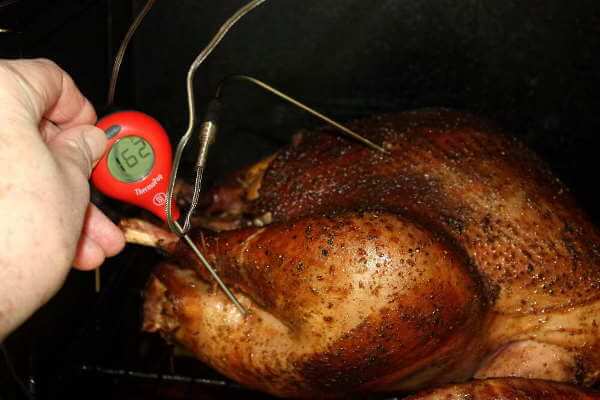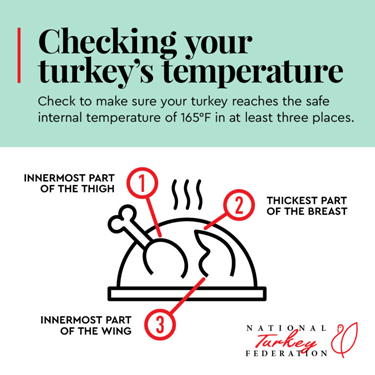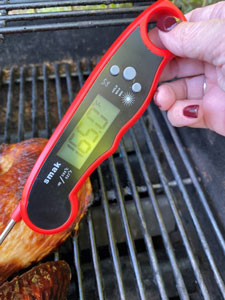Smoking a turkey can seem intimidating, but with the right techniques you’ll have moist flavorful and safe results every time. The secret? Proper thermometer placement. Monitoring temperature is absolutely crucial when smoking turkey to ensure it reaches a safe internal temp without overcooking.
In this comprehensive guide, I’ll walk you through everything you need to know about thermometer placement for smoked turkey. You’ll learn the best spots to check, thermometer types to use, accuracy tips, and more Let’s get smoking!
Why Temperature Matters So Much
Poultry must reach 165°F internally to eliminate bacteria that can cause dangerous foodborne illness. Salmonella and other pathogens can lurk in raw turkey, so hitting that food safe 165°F mark is critical.
However, you also want to avoid overcooking the turkey which leads to dry, stringy meat. That’s why constant temperature monitoring during the smoking process is so important. A good thermometer provides vital feedback so you can remove the turkey from the smoker right when it hits the ideal point of doneness between unsafe and overdone.
3 Key Areas to Check for Doneness
To get an accurate read on whether your turkey has reached a safe internal temperature, the thermometer probe should be inserted into three main areas:
-
Thickest part of the breast – Avoid bones or gristle when inserting here. Go for the densest section of meat.
-
Innermost portion of the thigh – Again aim for the thickest part furthest from the bone.
-
Innermost portion of the wing – Find the densest area away from the bone or joints.
Checking the temperature in multiple areas accounts for uneven cooking and ensures no part of the turkey falls below the 165°F minimum safe temperature.
Insert from the Side for Best Results
When working with boneless turkey breasts or ground turkey patties, insert your instant read or digital thermometer probe from the side rather than from the top. Inserting from the side gives you a more accurate and precise temperature reading.
Side insertion also makes it much easier to read the thermometer display without having to remove it from the turkey. You can conveniently monitor the climbing temp during the final phase of smoking.
Thermometer Options for Smoked Turkey
Let’s look at the thermometer options out there and which work best for monitoring the temperature of smoked turkey:
Oven-Safe Thermometers – These handy thermometers are designed to insert into the turkey and remain in place throughout the cooking process. The base of the thermometer sits outside the oven and shows the real-time internal temperature on an easy-to-read dial. Oven-safe thermometers work great for whole turkeys or turkey breasts.
Instant-Read Thermometers – As the name suggests, these provide quick and accurate temperature readings. Simply remove the smoked turkey from the grill or smoker, insert the probe into the thickest area, then wait 15-20 seconds for the digital display to reveal the internal temp. Instant-reads are fast and reliable.
Pop-Up Thermometers – Pre-inserted pop-up thermometers come in frozen turkeys. An indicator button “pops up” when the minimum safe temperature of 165°F is reached. Relying solely on the pop-up thermometer is risky, so experts recommend confirming the final temperature with a conventional digital or instant-read thermometer.
Proper Cleaning and Hygiene
To prevent dangerous cross-contamination between raw and cooked foods, it’s vital to properly clean and sanitize your thermometer probe before each use:
-
Wash the probe with hot, soapy water after every use.
-
Sanitize the probe by wiping with an alcohol pad, soaking in a diluted bleach solution, or dipping probe in boiling water for 30 seconds.
-
Always remove any residue with hot, soapy water after sanitizing.
Maintaining Accuracy
To keep your thermometer readings reliable:
-
Calibrate thermometers upon purchase and regularly after with an ice bath (should read 32°F) or boiling water (should read 212°F adjusted for altitude).
-
Replace batteries regularly, at least once a year.
-
Avoid harsh impacts and protect probe.
Smoking Turkey to Perfection
Beyond proper thermometer placement, certain finishing techniques help ensure your smoked turkey comes out perfectly juicy and delicious every time:
-
Brine the turkey for 12-24 hours before smoking to impart moisture and flavor.
-
Experiment with different rubs containing spices, herbs and sweet flavors. Apply rub under skin as well.
-
Use fruitwoods like apple, cherry or pecan which pair wonderfully with poultry. Hickory gives great smoky flavor too.
-
Maintain a consistent smoker temperature between 225-275°F.
-
Allow the smoked turkey to rest 20 minutes before slicing to retain juices.
Smoked Turkey FAQs
What type of thermometer is best for smoking turkey?
Instant-read is ideal for speed, but oven-safe dial thermometers work very well too. Go digital for greatest accuracy.
How long does it take to fully smoke a turkey?
Estimate around 30-45 minutes per pound to reach 165°F in the breast and thigh. 10-15 lbs turkeys take 6+ hours.
What temperature should I cook smoked turkey to?
Minimum 165°F in the thickest part of breast, thigh and stuffing for food safety.Shoot for 170°F for extra buffer.
Can I rely solely on a pop-up thermometer for doneness?
It’s risky to depend only on pop-ups. Always confirm the final temperature using a conventional digital or instant-read thermometer.
Take the Temperature, Take Charge of Perfection
Mastering thermometer placement means you’ll turn out mouthwatering smoked turkeys every time. No more guessing about doneness or biting into undercooked meat. Follow this guide for smoker success!
Sticking that probe in all the right spots gives you perfect feedback to cook smoked turkey safely and deliciously. Get ready for juicy, flavorful backyard birds that will make you the envy of the neighborhood. Happy smoking!

Where to Put the Thermometer in a Turkey

An important part of using any thermometer is the proper placement in the turkey. Unsure of where to put the thermometer in a turkey? Here are few tips to keep in mind:
- When preparing a whole turkey, insert the thermometer into the thickest portion of the turkey breast, the innermost portion of thigh and the innermost portion of the wing.
- Make sure the thermometer does not touch bone, gristle or the pan.
- When inserting the thermometer in a turkey breast or ground turkey patty, insert it from the side. The thermometer is easier to read and more accurate than when inserted from the top.
The internal temperature of your turkey (and any stuffing) should always reach 165°F.

According to the U.S. Food and Drug Administration, the percentage of consumers who own food thermometers has increased from 49 percent in 1998 to 70 percent in 2010. Both the National Turkey Federation and USDA recommend using a meat thermometer to ensure a delicious and safe meal.
Accurate temperatures, both in the oven and the turkey are important for quality and safety. A meat thermometer is a cook’s best friend when it comes time to prepare a meal.
Meat thermometers that can be calibrated for accuracy and instant-read/digital thermometers are our preferred choices. These types of thermometers are available at grocery, kitchen and hardware stores.
Don’t forget about your oven’s temperature! Check the oven thermostat and oven temperature to verify the oven setting. Recalibrate if necessary – a 25°F variation can make a 5 percent difference in cooked turkey yield. An oven that is too hot will dry and shrink the bird.
Check out USDA’s resource for more information on proper cooking temperatures.
This should be inserted into the turkey at the beginning of the cooking time and remain inserted in the bird while cooking. The temperature indicator will rise slowly as the turkey cooks. An oven-proof thermometer is ideal for the whole turkey and the turkey breast.
These thermometers enable you to measure the internal temperatures of meat with the most accurate reading in the quickest time possible. They are not designed to stay in the food during cooking. If you use this type, pull the turkey out of the oven far enough to insert the stem about 2 1/2 inches into the thickest part of the meat, but not touching bone or the roasting pan.
The sensing tip is a small indentation located about 1 1/2 inches from the end of the stem and must be fully inserted into the bird. (Look for a tiny dimple on the stem.) The temperature should register in about 15-20 seconds. Wipe with a sanitizer after each use and before the next use.
These are commonly found in the whole turkey and turkey breast. The “pop-up” thermometer device indicates the turkey has reached the final temperature for safety and doneness. Experts suggest the temperature be verified with a conventional thermometer.
USDA has a full listing of the various types of food thermometers available.
Food thermometers should be washed following use with hot soapy water and sanitized. Most thermometers, particularly digital and instant-read varieties, should not be immersed in water.
There are several ways to sanitize your thermometer:
- Use an alcohol swab to wipe the stem.
- Use a food-safe sanitizing solution, such as chlorine bleach and water, diluted according to the directions on the bottle, by holding it in the diluted mixture for a minimum of 10 seconds.
- Hold the stem in boiling water for no less than 30 seconds.
If using alcohol or a cleaning solution, make sure to wash the stem with soap and hot water to remove any residue.
